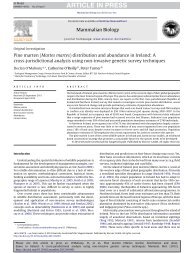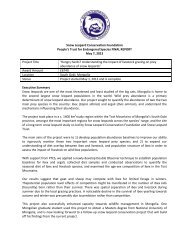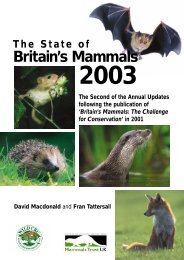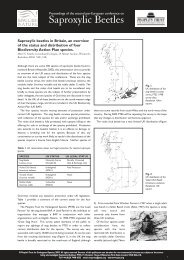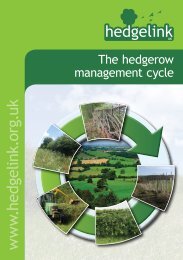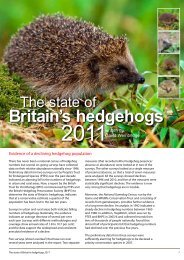the British saproxylic invertebrate fauna - People's Trust for ...
the British saproxylic invertebrate fauna - People's Trust for ...
the British saproxylic invertebrate fauna - People's Trust for ...
- No tags were found...
Create successful ePaper yourself
Turn your PDF publications into a flip-book with our unique Google optimized e-Paper software.
Proceedings of <strong>the</strong> second pan-European conference onSaproxylic BeetlesThe <strong>British</strong> <strong>saproxylic</strong> <strong>invertebrate</strong> <strong>fauna</strong>Keith Alexander, Ancient Tree Forum, 59 Sweetbrier Lane,Heavitree, Exeter EX1 3AQ, UK.AbstractThe compilation of a checklist of <strong>the</strong> <strong>fauna</strong> of <strong>saproxylic</strong><strong>invertebrate</strong>s has recently made it possible to identify how manyspecies are known to be dependent on <strong>the</strong> process of wood decayin trees and shrubs in <strong>the</strong> countryside of Britain and Ireland(Alexander, 2002).The answer is close to 1800 species <strong>for</strong> Britain anda little over 600 <strong>for</strong> Ireland.The figures <strong>for</strong> Coleoptera are 700 <strong>for</strong>Britain and 259 <strong>for</strong> Ireland (see Table 1).The immense nature conservation importance of decaying woodis emphasised by <strong>the</strong> fact that:● <strong>the</strong> 1800 species represent a major proportion - about 6%- of <strong>the</strong> total <strong>fauna</strong> known from Britain; and● 38% of <strong>the</strong> <strong>saproxylic</strong> <strong>invertebrate</strong> species haveconservation status in Britain, with Coleoptera having <strong>the</strong>highest figure of any taxonomic group - 54%.Despite this great importance, <strong>the</strong> biology of wood decay is verypoorly understood by most <strong>invertebrate</strong> specialists. A basicunderstanding of tree biology is needed if we are to successfullypromote <strong>the</strong> conservation of wood decay habitats and – our specialinterest - <strong>the</strong> associated <strong>fauna</strong>. Living trees contain dead woodnaturally and this has nothing to do with <strong>the</strong> health of <strong>the</strong> livingtissues. The heartwood decay succession is especially important tounderstand <strong>for</strong> <strong>the</strong> conservation of species such as Violet Click BeetleLimoniscus violaceus and Noble Chafer Gnorimus nobilis.IntroductionIn this paper I present <strong>the</strong> new annotated checklist of <strong>the</strong> <strong>British</strong><strong>saproxylic</strong> <strong>invertebrate</strong> <strong>fauna</strong> and some of <strong>the</strong> conclusions whichhave been drawn from <strong>the</strong> data.This leads on to a discussion of <strong>the</strong>importance of entomologists developing at least a basicunderstanding of <strong>the</strong> process of wood decay.The ChecklistThere has long been a need <strong>for</strong> a checklist of <strong>the</strong> <strong>saproxylic</strong><strong>invertebrate</strong>s. It has been needed <strong>for</strong> many reasons but especially to:● facilitate <strong>the</strong> recording of particular species on particularsites, to focus field workers on <strong>the</strong> significant habitatfeatures;● draw <strong>the</strong> attention of nature conservationists to <strong>the</strong>enormous variety of niches exploited in wooded habitatsand to emphasise <strong>the</strong> importance of wood decaysuccession;● stimulate ecological research of <strong>the</strong> <strong>fauna</strong>.A checklist has now been compiled <strong>for</strong> Britain and Ireland(Alexander, 2002) and this new publication was launched at <strong>the</strong>Symposium, with all delegates being provided with a complimentarycopy.The checklist is provided as “provisional” quite simply because of<strong>the</strong> enormity of <strong>the</strong> task. The publication represents <strong>the</strong> stage atwhich <strong>the</strong> compilation has reached by June 2002. Much literature isstill to be searched; many experts are still to be consulted. It is hopedthat <strong>the</strong> delegates at <strong>the</strong> Symposium will contribute in two ways:● provide additional in<strong>for</strong>mation on <strong>the</strong> known biology orecology of <strong>the</strong> species listed, or to propose additionalspecies or deletions;● work towards generating a comparable list <strong>for</strong> <strong>the</strong>ir owncountries or regions.One of <strong>the</strong> shortcomings of attempts to list <strong>the</strong> European <strong>saproxylic</strong>species most in need of conservation – <strong>for</strong> <strong>the</strong> Berne Convention orHabitats & Species Directive, <strong>for</strong> example - has been a lack ofcomparable in<strong>for</strong>mation across <strong>the</strong> whole continent. Speight (1989),<strong>for</strong> instance, focused on a few families of larger and more attractiveColeoptera <strong>for</strong> practical reasons ra<strong>the</strong>r than scientific ones, and thishas <strong>for</strong>med <strong>the</strong> basis <strong>for</strong> <strong>the</strong> species selected <strong>for</strong> listing by <strong>the</strong>Council of Europe and <strong>the</strong> European Commission.Wood decayThe definition of <strong>saproxylic</strong> used as a basis <strong>for</strong> this presentation isas follows:● <strong>the</strong> immature stages of <strong>the</strong> <strong>invertebrate</strong> develop in somepart of <strong>the</strong> wood decay succession or in its products;● <strong>the</strong> wood decay succession is itself defined as including allstages from <strong>the</strong> un-decayed wood right through to <strong>the</strong>Table 1:Comparison ofnumbers ofColeoptera,Diptera and totalInvertebrates on<strong>the</strong> <strong>saproxylic</strong>checklist, within<strong>for</strong>mation onconservation statusTaxonomicgroupingNumber of<strong>saproxylic</strong>species reportedfrom IrelandNumber of nativeGB <strong>saproxylic</strong>species(excludingextinct species)Number ofNationallyScarce*<strong>saproxylic</strong>species in GBNumber of RedData Book*<strong>saproxylic</strong>species in GB% of GBspecies withconservationstatusColeoptera 259 700 219 162 54Diptera 293 730 99 143 33All <strong>invertebrate</strong>s 615+ 1792+ 354 327 38*Nationally Scarce – species believed to be confined in Britain to 100 or fewer 10km squares of <strong>the</strong> Ordnance Surveynational grid. Red Data Book – species believed to occur in fewer than 15 of <strong>the</strong> 10km squares© People’s <strong>Trust</strong> <strong>for</strong> Endangered Species, 2003 All rights reserved. Extracts of this publication can be taken <strong>for</strong> non-commercial, in-house use, subject to <strong>the</strong> sourcebeing acknowledged. Registered Address: PTES, 15 Cloisters House, 8 Battersea Park Road, London SW8 4BG, UK.Tel: +44 (0)20 7498 4533 email: enquiries@ptes.org web:www.ptes.org1
fully decayed wood mould which is barely distinguishablefrom soil or peat.The process of wood decay is a very specialist subject, with fewpeople expert. It is not surprising that few <strong>invertebrate</strong> specialistshave even a basic understanding of <strong>the</strong> fungal decay of wood.Thereare notably few mycologists who do! In Britain we are <strong>for</strong>tunate inhaving two key academics - Alan Rayner and Lynne Boddy (Boddy,1994; Boddy & Rayner, 1983; Rayner, 1993, 1996; Rayner & Boddy,1988) – as well as <strong>the</strong> environmental campaigner Ted Green (Green,1991, 1993), who have done much to make <strong>the</strong>ir knowledge availableoutside of <strong>the</strong> specialist literature.Despite this, a widespread lack of understanding has seriousconsequences <strong>for</strong> conservation and ill-in<strong>for</strong>med conservationpractices are rife.The ageing process in trees and shrubsAll woody plants appear to go through much <strong>the</strong> same stages in <strong>the</strong>irdevelopment. Each year a layer of new tissue is generated by <strong>the</strong>cambial layer – <strong>the</strong> annual ring. As <strong>the</strong> tree or shrub grows, <strong>the</strong>diameter of <strong>the</strong> stem increases and so <strong>the</strong> circumference of <strong>the</strong>annual ring necessarily increases. The actual depth of each growthring is influenced by many things, particularly <strong>the</strong> quality of <strong>the</strong>growing season. But some general trends can be identified:● <strong>the</strong> volume of new tissue contained in each successivering steadily increases as <strong>the</strong> canopy of foliage-bearingbranches increases in size and develops to its maximumextent;● once <strong>the</strong> canopy has reached maximum development <strong>for</strong><strong>the</strong> species and <strong>the</strong> situation in which <strong>the</strong> individual isgrowing, <strong>the</strong>n <strong>the</strong> volume of new tissue in each successiveannual ring remains relatively constant;● eventually a situation is reached whereby <strong>the</strong> new ringhas to encompass such a large girth of stem, and yet drawon a no-longer increasing leaf area <strong>for</strong> carbohydrates, thatit must fragment, and cease to be a continuous ring ofliving tissue;● in parallel to this change to <strong>the</strong> main stem or trunk, <strong>the</strong>canopy itself becomes unsustainable (<strong>the</strong> reasons are notunderstood), <strong>the</strong> upper branches begin to die back and<strong>the</strong> canopy starts to thin;● as light increasingly reaches <strong>the</strong> lower parts of <strong>the</strong> tree,through <strong>the</strong> declining high canopy, so new and vigorousgrowth occurs throughout <strong>the</strong> lower canopy – a processwhich has been called “retrenchment” or “growingdownwards”;● eventually a new, lower canopy is established – this stagein <strong>the</strong> tree’s growth is termed <strong>the</strong> “ancient” tree andancient trees may live a very long time, often manycenturies.The pattern of growth and development described above relates toopen-grown trees or shrubs, which have space <strong>for</strong> optimaldevelopment and are not affected by competition from o<strong>the</strong>r treesor shrubs. Clearly, where canopy competition is occurring, growingdownwards will lead to <strong>the</strong> early death of <strong>the</strong> individual as itbecomes over-shaded.The process offungal decay of woodThe annual growth ringsbuild up. As <strong>the</strong>y<strong>the</strong>mselves age <strong>the</strong>n<strong>the</strong>y begin to die off.Thepattern of death of <strong>the</strong>growth rings variesfrom species to species.In oak, <strong>the</strong> rings aregenetically preprogrammedto die afterabout 20 or so years andso a definite “heartwood”is produced – a deadwoody core to <strong>the</strong> tree. Inbeech, <strong>the</strong> rings die moreerratically and <strong>the</strong> core of<strong>the</strong> tree has a mix of deadAn ancient sweet chestnut Castanea sativasplit in half during a storm, revealingcomplete hollowing of <strong>the</strong> trunk by <strong>the</strong> fungusLaetiporus sulphureus, and accumulateddebris in <strong>the</strong> base - this "wood mould" is <strong>the</strong>rarest habitat <strong>for</strong> <strong>saproxylic</strong> beetles acrossEurope. Photo by KNA Alexander.and living rings, and so this species is said to not have a trueheartwood.These two distinct patterns of ring death may not be <strong>the</strong>whole story as this aspect of tree biology is also not well understood.Whichever pattern is occurring in a particular tree or shrub, <strong>the</strong>key thing from a <strong>saproxylic</strong> point of view is that each individual treeor shrub increasingly accumulates dead tissues within <strong>the</strong> core of<strong>the</strong>ir stems.These tissues arguably serve no function to <strong>the</strong> tree orshrub – <strong>the</strong>re are apparently valid engineering arguments that saythat, on <strong>the</strong> one hand, a solid trunk is better <strong>for</strong> tree survival, and, on<strong>the</strong> o<strong>the</strong>r, a hollow stem is better. What is certain however is that<strong>the</strong>se dead tissues will be colonised by wood-decay fungi at somestage, in many - but not all - cases still while <strong>the</strong>y are envelopedwithin <strong>the</strong> living outer ring of <strong>the</strong> tree’s tissues.Fungal decay of wood can take a variety of routes.The two which aremost significant to <strong>saproxylic</strong> entomologists are red-rot (referred toas brown-rot by arborists) and white-rot. The main components ofwood are lignin and cellulose.All of <strong>the</strong> wood-decay fungi break downcellulose but not all can break down <strong>the</strong> lignin. If <strong>the</strong> lignin is leftbehind <strong>the</strong>n it remains as <strong>the</strong> characteristic hard, but brittle, red-rotstructures.Where lignin and cellulose are both broken down <strong>the</strong>n <strong>the</strong>decay produces a paler and softer material, termed white-rot.Eventually <strong>the</strong> whole dead core of tree rings is broken down, leavinga hollow cavity, and debris accumulates in its base – <strong>the</strong> dark woodmould,comprising a complex mixture of composted and compostingdegraded woody tissues, <strong>invertebrate</strong> faecal pellets, etc. Where <strong>the</strong>cavities have been used by nesting or roosting birds, or bats, <strong>the</strong>no<strong>the</strong>r debris may have been introduced, including nesting materials,vertebrate faeces and urine, discarded fea<strong>the</strong>rs, and even <strong>the</strong> remainsof <strong>the</strong> vertebrates <strong>the</strong>mselves which have died.The vertebrates mayalso have brought in o<strong>the</strong>r organisms, eg discarded owl pellets willinclude small mammals remains and fragments of o<strong>the</strong>r food,including, in <strong>the</strong> case of little owl, a variety of large <strong>invertebrate</strong>s.More than one fungus – species or individual – may be activewithin <strong>the</strong> trunk of a particular tree or shrub at any one time.Thesemay be breaking down tissues in parallel, or exploiting material indifferent stages of decay.Once a stem has been hollowed, <strong>the</strong> living outer tissues arecontinuing to grow - new growth rings continue to be laid down eachyear. The living tissues are not being harmed by <strong>the</strong> decay fungi.Eventually <strong>the</strong>se “new” growth rings will begin to die and a new cycleof fungal colonisation begins.2
The individual tree actual benefits from <strong>the</strong> fungal decay of its deadheartwood tissues. Resources are locked up in <strong>the</strong>se dead tissues.Fungal decay makes <strong>the</strong>m accessible again to <strong>the</strong> tree as well as to<strong>the</strong> fungi and <strong>invertebrate</strong>s. Roots may grow inwards, into <strong>the</strong> debriswithin <strong>the</strong> cavities and make use of <strong>the</strong> breakdown products.The fungal and <strong>invertebrate</strong> communities of wood decayThere are many thousands of species of fungi that exploit <strong>the</strong> deadwoody tissues of trees and shrubs. Heartwood decay – as describedabove – is just one part of <strong>the</strong> story. O<strong>the</strong>r fungi are active on deadbranches within <strong>the</strong> canopy, o<strong>the</strong>rs on <strong>the</strong> bark, o<strong>the</strong>rs on deadroots. A small minority of fungi are actually pathogens or parasitesand feed on living woody tissues, <strong>the</strong> <strong>for</strong>mer causing death of tissuesei<strong>the</strong>r locally or to <strong>the</strong> whole organism.Thus a large and wide variety of fungal species are active in <strong>the</strong>decay process, and <strong>the</strong>re are successions of decay. Each tree or shrubspecies has a particular suite of fungal species associated with <strong>the</strong>m,although few individual species of fungi are confined to one particulartree or shrub species.The array of niches in <strong>the</strong> wood-decay process<strong>for</strong> <strong>invertebrate</strong>s is immense and, until now, only guestimates ofspecies-richness were possible.The debris accumulating within tree cavities is <strong>the</strong> end point of <strong>the</strong>decay succession and <strong>the</strong>re<strong>for</strong>e – in a natural tree population – is <strong>the</strong>rarest component. It takes a long period of time <strong>for</strong> a species suchas an oak to reach a large size and <strong>for</strong> fungal decay to reach <strong>the</strong>hollow cavity stage. Over such a long space of time much can happento kill <strong>the</strong> tree prematurely. In modern Europe <strong>the</strong>re are manypressures on trees and large old hollow individuals are now verymuch <strong>the</strong> exception over large areas of countryside. It is <strong>the</strong>re<strong>for</strong>eno coincidence that some of our rarest and most threatened<strong>saproxylic</strong> beetles are those which develop in <strong>the</strong> debris of cavitiesin old trees. Limoniscus violaceus, Gnorimus nobilis and G. variabilis areexcellent examples which are exceedingly localised in modern Britainand which need special conservation measures. Osmoderma eremita isano<strong>the</strong>r example so localised in Europe that it is absent from Britain.Conclusions from <strong>the</strong> checklistThe compilation of <strong>the</strong> checklist has made it possible to identify howmany of our species are known to be dependent on <strong>the</strong> process ofwood decay – <strong>the</strong> succession from <strong>the</strong> living wood through to <strong>the</strong>fully degraded wood mould.The answer is close to 1800 species <strong>for</strong>Britain and a little over 600 <strong>for</strong> Ireland. The figures <strong>for</strong> Coleopteraare 700 <strong>for</strong> Britain and 259 <strong>for</strong> Ireland.The immense nature conservation importance of decaying woodis emphasised by <strong>the</strong> fact that, overall, 38% of <strong>the</strong> <strong>saproxylic</strong><strong>invertebrate</strong> species have conservation status in Britain, withA sawn section of an old orchard plum tree Prunus domesticashowing advanced hollowing by <strong>the</strong> fungus Laetiporus sulphureus andlarvae of Noble Chafer Gnorimus nobilis in <strong>the</strong> wood mould debris within<strong>the</strong> cavity. Photo by Colin Twissell.Violet click beetle Limoniscus violaceus, a species which develops in <strong>the</strong> woodmould debris in <strong>the</strong> base of hollow trees. Photo by RS Key.Coleoptera having <strong>the</strong> highest figure of any taxonomic group - 54%.Very few of <strong>the</strong> <strong>invertebrate</strong> species listed can feed directly on <strong>the</strong>dead wood.The majority are dependent on fungi to break down <strong>the</strong>cellulose, lignin and o<strong>the</strong>r constituents into simpler, more digestiblesubstances.Well-known exceptions to this include <strong>the</strong> Scolytidae andCerambycidae which carry micro-organisms in <strong>the</strong>ir guts which canbreak <strong>the</strong>se complex substances down.Key messages from this paper are:● ageing is a natural process;● heartwood decay and hollowing are also natural processes;● dead wood and decay are a normal part of a healthy tree;● <strong>saproxylic</strong> specialists need to be promoting <strong>the</strong>semessages within <strong>the</strong> conservation movement if we wantour interests to be conserved.AcknowledgementsMy understanding of tree biology and fungal decay has been gained entirelythrough my association with <strong>the</strong> Ancient Tree Forum and I would like toacknowledge <strong>the</strong> inspiration generated by some of <strong>the</strong> key people, notablyTed Green, Nev Fay, Jill Butler, Caroline Davis,Vikki Forbes and Helen Read.I would also like to thank Roger Key and Jon Webb of English Nature <strong>for</strong><strong>the</strong>ir support and encouragement with <strong>the</strong> checklist project.ReferencesAlexander, K.N.A. (2002) The <strong>invertebrate</strong>s of living and decayingtimber in Britain and Ireland – a provisional annotated checklist. EnglishNature Research Reports No. 467.Boddy, L. (1994) Wood decomposition and <strong>the</strong> role of fungi:implications <strong>for</strong> woodland conservation and amenity treemanagement, pages 7-29, In: Spencer, J., & Feest, A., eds, Therehabilitation of storm damaged woods. University of Bristol:Department of Continuing Education.Boddy, L. & Rayner, A.D.M. (1983) Origins of decay in livingdeciduous trees: The role of moisture content and a re-appraisal of<strong>the</strong> expanded concept of tree decay. New Phytologist 94: 623-641.Green,T. (1991) Simply fungi. pp 26-27. In: H.J. Read (ed) Pollard andveteran tree management. Corporation of London.Green,T. (1993) Inonotus hispidus on apple trees. Mycologist 7 (2): 80-83.Rayner, A.D.M. (1993) The fundamental importance of fungi inwoodlands. <strong>British</strong> Wildlife 4: 205-215.Rayner,A.D.M. (1996) The tree as a fungal community. pp6-9. In: H.J.Read (ed.) Pollard and veteran tree management II. Corporation ofLondon.Rayner, ADM, & Boddy, L. (1988) Fungal decomposition of wood: itsbiology and ecology.John Wiley & Sons.Speight, M.C.D. (1989) Saproxylic <strong>invertebrate</strong>s and <strong>the</strong>ir conservation.Nature and Environment Series No. 42. Council of Europe, Strasburg.3





